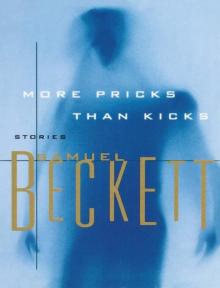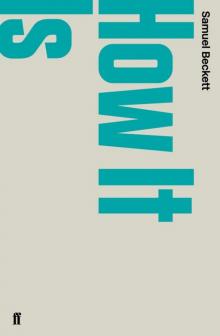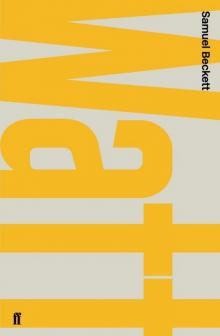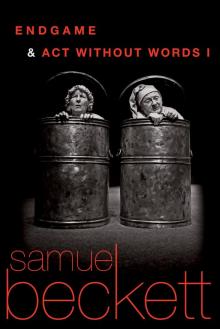- Home
- Samuel Beckett
Texts for Nothing and Other Shorter Prose 1950-1976
Texts for Nothing and Other Shorter Prose 1950-1976 Read online
SAMUEL BECKETT
Texts for Nothing and Other Shorter Prose, 1950–1976
Edited by Mark Nixon
Contents
Title Page
Preface
Table of Dates
Texts for Nothing
I
II
III
IV
V
VI
VII
VIII
IX
X
XI
XII
XIII
From an Abandoned Work
Faux Départs
All Strange Away
Imagination Dead Imagine
Enough
The Lost Ones
Ping
Lessness
Fizzles
He is barehead
Horn came always
Afar a bird
I gave up before birth
Closed place
Old earth
For to end yet again
Still
As the Story Was Told
La Falaise/The Cliff
neither
Appendix 1: ‘Still’ Texts
Sounds
Still 3
Appendix 2: Publication History
About the Author
About the Editor
Titles in the Samuel Beckett series
Copyright
Preface
By 1957, Beckett had revolutionised the world of theatre with Waiting for Godot and Endgame and had also redrawn the boundaries of prose fiction. But the three post-war novels which came to be known as the Trilogy – Molloy, Malone Dies and The Unnamable – brought him to a textual dead end from which he found it difficult to continue. The final words of that last novel, The Unnamable, ‘I can’t go on, I’ll go on’, encapsulate the tensions underlying Beckett’s own subsequent literary movements. As he stated in a letter to Mary Hutchinson, ‘there seems to be no “going on”, for me, from the Innommable [The Unnamable]’.1 In many ways, the prose works that Beckett would write over the next forty years were characterised by his sense that they were ‘faux départs’ (‘false starts’); texts which no sooner begun ended in abandonment, or were discarded after a long struggle to find the path to a satisfactory conclusion. Beckett in these years told a friend that there were two rewarding moments in his creative endeavours, the one where he started a text, and the other where it ended in the waste-paper basket.
The difficulty of writing, and Beckett’s own sense of failure, rendered a large part of the corpus from these years ultimately incomplete. Titles such as From an Abandoned Work suggest the quality of drafts, elevated to the status of ‘finished’ works by ever more insistent publishers and public interest.2 Moreover, the compositional processes of these short prose works are intricately connected and intriguingly self-referential; this is no longer a writer who starts and completes a work, but one who across a wide range of texts realises that there is no possibility of completion. As the surviving manuscripts from this period show, Beckett would start one text, lay it aside to start another, and then return to the original, or amalgamate the two, or abandon both. ‘No matter, fail again, fail better’, to quote Worstward Ho, appears to have been the guiding principle. We are thus perhaps not to view these prose pieces as separate, individual entities, but as an on-going corpus of writing circling around what From an Abandoned Work calls ‘all the variants of the one’. Themes, words, sentences and images resurface again and again across this writing, as well as in the works written for television or theatre.
With the exception of Comment c’est (1961), Beckett’s creative landscape in the years after 1950 is littered with ever shorter, ever more pared-down texts, moving towards what the first Fizzle (‘He is barehead’) calls the ‘minima’. One could argue that the Joycean exuberance of the early work of the 1930s and 1940s (aspiring to the master’s ‘Work in Progress’) made way for what Beckett would call his ‘work in regress’ (note the lower case), the search for a distillation of existential and verbal expression. Moreover, Beckett wrote mostly in French during these years, and then faced the challenge of translating (or rather transmitting) the recalcitrant results into English.
Beckett’s failure to find the right way of expressing his failure to express was compounded by the inability of his English language publishers to print his texts with adequate care. As was the case with the journals and newspapers in which many of them first appeared, Beckett’s trade publishers in England (John Calder) and America (Grove Press) often failed to meet the challenge of presenting these exacting works. Part of the problem lay precisely in the fact that there were two English language publishers; as Beckett told the English scholar John Fletcher: ‘There are often variants between English & American editions because different proofs corrected at different times.’3 A survey of the different publications reveals that Beckett’s short prose has frequently appeared in erroneous forms. This is especially regrettable in the case of these particular works, in which the precision of language – from repetition to punctuation and typographical presentation – is so crucially important.
The present edition takes an eclectic approach to these texts, in so far as all available material evidence – Beckett’s manuscripts, typescripts, correspondence with publishers, as well as page and galley proofs – has been taken into account. The most reliable texts thus far of Beckett’s post-war prose are contained in S. E. Gontarski’s edition of The Complete Short Prose, 1929–1989, published by Grove Press in 1995 (hereafter cited as ‘Grove 1995’), which has been followed as a base text against which to check the above evidence, being more reliable than Calder’s Collected Shorter Prose, 1945–1980 (hereafter cited as ‘Calder 1984’), which is riddled with errors despite the fact that Beckett read proof.
In terms of the ordering of contents, the decision was made to present these prose pieces (as far as possible) by order of composition, while at the same time upholding the ‘groupings’ seen into print by Beckett.4 This allows the reader to follow Beckett’s developing aesthetic and the dialogue established between texts. The only difficulty with this procedure concerns Fizzles (or Foirades in French), consisting of eight distinct short prose texts. As John Pilling has argued, Beckett most probably wrote the first five (in French) as early as 1954. He then proceeded to write ‘Se Voir’ (‘Closed place’) in 1968, began writing ‘Pour finir encore/For to End Yet Again’ in French in 1969 and wrote ‘Still’ in English in 1972. These texts, written across a span of nearly twenty years, were then brought together in French (as Pour finir encore et autres foirades by Les Éditions de Minuit) and in English (as For to End Yet Again and Other Fizzles by Calder, and as Fizzles by Grove Press) in 1976, each edition arranging the texts in a different order. By upholding the integrity of this group, their individual interaction with other pieces written in the interim is slightly obscured. (Thus, for example, ‘Se Voir/Closed place’, written in 1968, essentially reworks Le Dépeupleur/The Lost Ones, which Beckett began in 1966 but then abandoned, and only completed – with an additional final paragraph – in 1970.)
Furthermore, we need to remember that all of the so-called Fizzles were published individually in a magazine, before being collected in volume form. The same can be said of many of the works in the present edition. First published as individual slim volumes or in periodicals, they were only later ‘collected’ in larger gatherings. As his correspondence with publishers makes clear, Beckett acceded to the request for (in John Calder’s words) ‘acceptably sized volume[s]’ by handing over whatever was still unpublished, and allowing texts previously published in limite
d editions or magazines to be reprinted.5 This is the background to volumes such as No’s Knife: Collected Shorter Prose, 1945–1966 (Calder & Boyars, 1967) and Six Residua (Calder, 1978). At the same time, there is no doubt that Beckett viewed the texts gathered under the title Fizzles as belonging together, and the present edition upholds this coherence. I have chosen to place Fizzles according to the composition date of the latest text, though the reader should be mindful that they were written across a period of nearly twenty years.
Texts for Nothing
Beckett started writing the thirteen Texts for Nothing in French on Christmas Eve 1950, and finished them a year later in late December 1951.6 He had a clear sense of what he was trying to achieve – as with the three novels of the Trilogy, the manuscripts of the Textes pour rien show remarkably little revision.7 However, the English translation proved a rather more arduous affair, and dragged on, or rather off and on, for nearly fifteen years. He began translating immediately after finishing the French versions, in December 1951, but abandoned the task a year later. He resumed working on them in 1958 and again in 1963, but only completed the translations of all thirteen texts in December 1966. They first appeared together in English in No’s Knife: Collected Shorter Prose, 1945–1966 (Calder and Boyars, 1967) – the title is taken from ‘Text for Nothing XIII’ – and in the same year in Stories and Texts for Nothing (Grove Press). Beyond minor issues of spelling, the texts of these stories have remained relatively uncorrupted across subsequent publications, and the current edition makes only two changes.8 In ‘Text for Nothing IX’, Grove Press editions give ‘resumed by old offence’, following Beckett’s typescript. The current edition gives ‘resumed my old offence’, following the French original and Calder. In ‘Text for Nothing IV’, ‘in the pit of my inexistence’ is restored (Calder 1984 gives ‘in the pit of my existence’ – a reminder that Beckett himself, when reading proof, was capable of missing errors).
The Texts for Nothing are often neglected, but in important ways they enabled Beckett to move beyond the Trilogy to the works of the later years. If the Trilogy still contained a recognisable plot loosely based on the quest narrative, the Texts for Nothing foreground a disintegration that the monologue of a troubled consciousness is unable to remedy. As ‘Text for Nothing IV’ boldly declares, there is ‘no need for a story’. Having written these thirteen texts, Beckett again struggled to find a way to proceed. The manuscript notebook containing the second half of the French Textes pour rien also contains the drafts of four further prose pieces, all of which were, however, subsequently abandoned. Often mistakenly seen as further ‘Texts for Nothing’, these pieces differ significantly in terms of nature and tone. They develop a more clearly discernible plot, and they are also longer. Dissatisfied with these drafts, Beckett sought to solve his creative problem by changing language (back to English), a strategy which had served him well after he had started writing in French in 1946. And with his next prose work, From an Abandoned Work, Beckett began to concentrate his ideas in ever-shorter forms.
From an Abandoned Work
It is difficult to date the composition with any certainty. Beckett later remembered it as written in 1954/1955, but John Pilling convincingly dates its composition to spring/summer 1954. The first work to be written in English after Watt (completed 1945), From an Abandoned Work represents a watershed in Beckett’s writing. As Pilling has shown, the text as published is far shorter than the original manuscript draft, and thus represents one of the first instances of Beckett’s later habit of textual distillation and contraction.9 Shot through with an atmosphere of narrative incoherence and arbitrariness, the story deals with the memory of three days recounted by a now old man. It was first published (with considerable editorial revision, and with what Beckett called ‘varsity punctuation’) in the Dublin undergraduate organ, Trinity News, on 7 June 1956, and (also with errors) in Grove Press’s Evergreen Review a year later. The BBC broadcast a cleaned-up version on 14 December 1957 as ‘The Meditation’, spoken by Patrick Magee, which was subsequently published independently by Faber and Faber in 1958. The text in the present edition differs in one instance from Calder 1984 and Grove 1995 – both of which print: ‘Now was this my first experience of this kind, that is the question that immediately assails me’ – by restoring ‘assails one’, in agreement with all the early printings, and as conforming both to the lexical pattern of the text and to Beckett’s subsequent French translation; nor is there material evidence that he wanted the change to be made.10
After From an Abandoned Work, Beckett turned his attention to drama, and, with the exception of five of the Foirades/Fizzles, which were consigned to a drawer for nearly twenty years, the only prose work to surface in the next decade was How It Is. This longer piece of fiction remains one of Beckett’s most remarkable literary and, considering the psychological effort its composition demanded, emotional achievements. Written as Comment c’est between December 1958 and summer 1960, and translated into English by the end of January 1962, the novel variously anticipates the poetic starkness of Beckett’s later short prose.
Faux Départs
In August 1964, Beckett began a new, longish work in English provisionally entitled ‘Fancy Dying’. Ultimately abandoned, it spawned several separate texts of differing degrees of completion. Dating from August or September 1964, and given the overall title Faux Départs, four extracts (three in French and one in English) were published in the German literary journal Kursbuch (June 1965). These ‘false starts’ mark a change in Beckett’s prose writing, initiating a series, epitomising what Beckett frequently referred to as ‘residual’ pieces or ‘Residua’, that concentrates on the workings of the imagination in order to construct geometrically defined ‘closed spaces’, in which human figures are placed or rather arranged. The opening of the English extract is a version of material found in All Strange Away, while the three French extracts anticipate Imagination morte imaginez. Taken together, these brief passages represent stages of Beckett’s experimentation with a new kind of writing, and their appearance in print showed his increased willingness to allow fragments to be published.
All Strange Away
All Strange Away grew out of ‘Fancy Dying’ and represents the first in a series in which objects and figures are arranged and rearranged in confined spaces with mathematical precision. It deliberates on the conditions inside this entombed place, paying detailed attention to temperature, lighting and dimensions, as well as to the relationship between silence and sounds, and between degrees of whiteness. The language is minimal, estranged, sparse yet suggestive. An elliptical text, All Strange Away responds to the fourth Faux Départ, and was abandoned in early 1965. However, in order to raise money for the widow of the actor Jack McGowran, Beckett returned to it, submitting All Strange Away in 1973 to the Gotham Book Mart for a limited edition illustrated by Edward Gorey (published in 1976).
In terms of printing errors, All Strange Away has fared worst of all Beckett’s prose texts. All six subsequent reprints introduce new errors, beginning with the version appearing in the Journal of Beckett Studies (1978). Calder’s volume publication of All Strange Away (1979) introduced further errors. Beckett corrected several of these when he read proof for Calder in 1984, yet inexplicably Calder reverted to the original and erroneous 1979 text in the later collection of shorter prose entitled As the Story Was Told (1990). In his notes to Grove 1995, S. E. Gontarski argues that the text printed in Rockaby and Other Short Pieces (Grove, 1981) represents the most stable version, since Beckett ostensibly read proof for this volume.11 However, Grove 1995 at times ignores changes introduced in that volume, reprinting (correctly), for example, ‘from ground top of swell’ rather than the 1981 ‘from ground top to swell’.12 Indeed, the proofs for Rockaby and Other Short Pieces are problematic, Beckett having communicated corrections to Grove’s publisher, Barney Rosset, by phone.
Imagination Dead Imagine
When Beckett abandoned All Strange Away early in 1965, he had al
ready been working (this time in French) on a new text, Imagination morte imaginez. Indeed, Imagination Dead Imagine was generated from the textual ruins of All Strange Away, and Beckett referred to it as the ‘residual precipitate’ of the earlier text. The two works share many similar features, not least the opening words ‘Imagination dead imagine’ (which also opens the fourth Faux Départ). The French text was finished on 19 March 1965 and published later that year in Les Lettres nouvelles, while the English translation was first published in the Sunday Times of 7 November 1965. The first independent volume publications were by Calder in 1965 and then in Grove’s Evergreen Review of February 1966.13 The current edition retains the text of Calder 1984 and Grove 1995, but deviates in one instance, restoring the comma in ‘alone are stable, as is stressed’, following Beckett’s typescript and the Sunday Times text.
Beckett would make the closed space of Imagination Dead Imagine the focus of his creative endeavours over the following years, in both prose and drama (and television, if one thinks of Ghost Trio). In these works, immobile figures are ‘imagined’ and positioned by a dying imagination. The detached narration, the mathematical, even scientific tone of observation, connect an abstract and impersonal realm with a residual humanity.
Enough
In 1968, Beckett told Ruby Cohn that he wrote the prose text Enough ‘aberrantly’, between Imagination Dead Imagine and Bing.14 Announcing a stark break in its opening line, ‘All that goes before forget’, it does indeed differ from the two surrounding works, while clearly revisiting familiar territory. In terms of both its unexceptional language and its first-person narrative, Enough is more accessible than the other prose pieces from the 1960s and 1970s, and returns to the journey theme that had marked Beckett’s work from the 1950s. Written in French as Assez between September and December 1965 (and published the following year by Les Éditions de Minuit), the English translation first appeared in the April 1967 issue of Books and Bookmen.

 More Pricks Than Kicks
More Pricks Than Kicks Happy Days
Happy Days Breath, and Other Shorts
Breath, and Other Shorts Endgame & Act Without Words
Endgame & Act Without Words The Collected Shorter Plays of Samuel Beckett
The Collected Shorter Plays of Samuel Beckett The Complete Short Prose, 1929-1989
The Complete Short Prose, 1929-1989 Stories and Texts for Nothing
Stories and Texts for Nothing Waiting for Godot
Waiting for Godot Rockaby and Other Short Pieces
Rockaby and Other Short Pieces First Love and Other Shorts
First Love and Other Shorts How It Is
How It Is Disjecta: Miscellaneous Writings and a Dramatic Fragment
Disjecta: Miscellaneous Writings and a Dramatic Fragment Echo's Bones
Echo's Bones Texts for Nothing and Other Shorter Prose 1950-1976
Texts for Nothing and Other Shorter Prose 1950-1976 Three Novels
Three Novels Murphy
Murphy Mercier and Camier
Mercier and Camier Eleuthéria
Eleuthéria Selected Poems 1930-1988
Selected Poems 1930-1988 Dream of Fair to Middling Women
Dream of Fair to Middling Women Watt
Watt Krapp's Last Tape and Other Dramatic Pieces
Krapp's Last Tape and Other Dramatic Pieces The Complete Dramatic Works of Samuel Beckett
The Complete Dramatic Works of Samuel Beckett Worstward Ho
Worstward Ho Collected Poems in English and French
Collected Poems in English and French Company / Ill Seen Ill Said / Worstward Ho / Stirrings Still
Company / Ill Seen Ill Said / Worstward Ho / Stirrings Still Ends and Odds
Ends and Odds Endgame Act Without Words I
Endgame Act Without Words I Rockabye and Other Short Pieces
Rockabye and Other Short Pieces The Collected Shorter Plays
The Collected Shorter Plays The Complete Dramatic Works
The Complete Dramatic Works Three Novels: Malloy, Malone Dies, The Unnamable
Three Novels: Malloy, Malone Dies, The Unnamable The Unnamable
The Unnamable